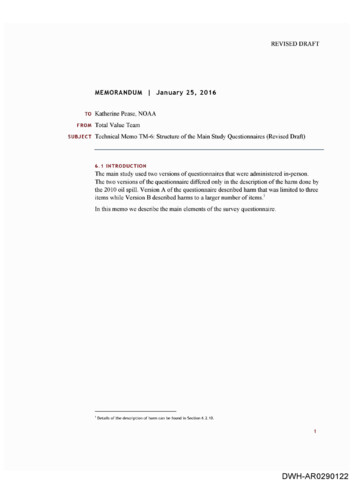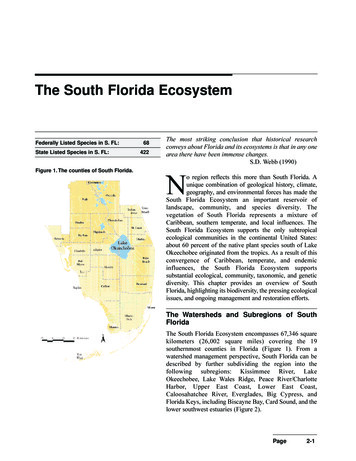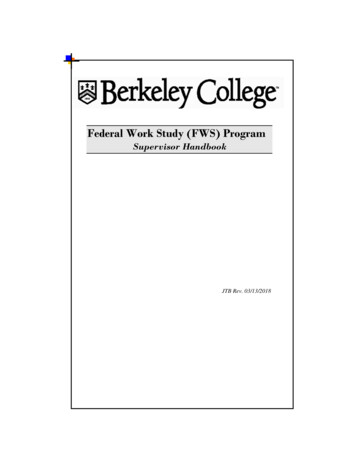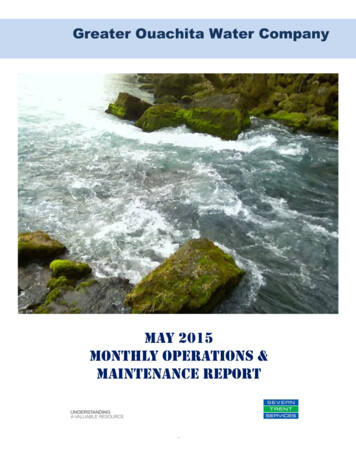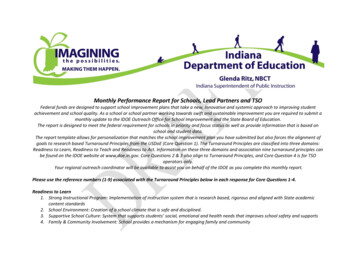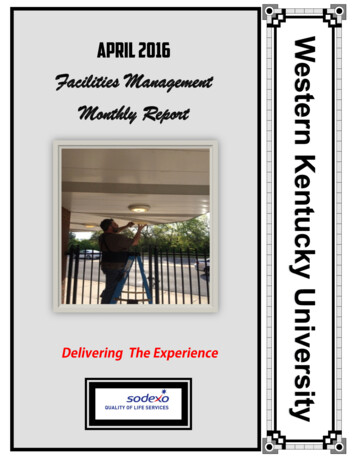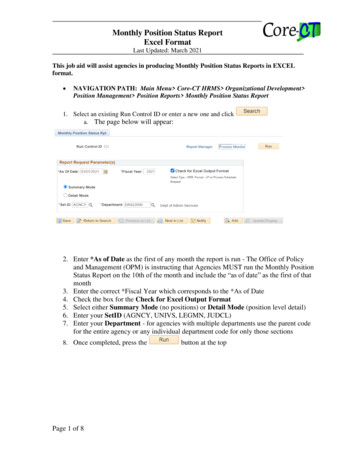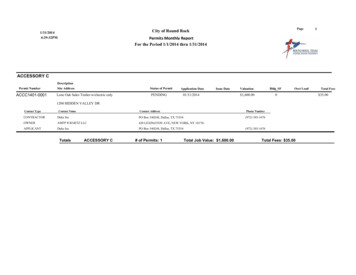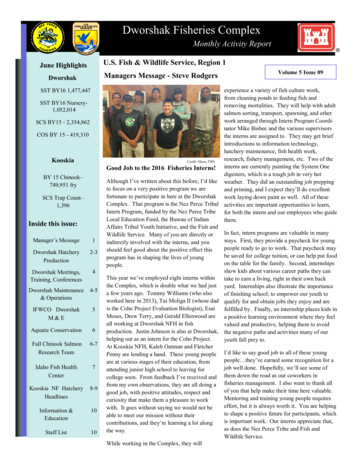
Transcription
Dworshak Fisheries ComplexMonthly Activity ReportU.S. Fish & Wildlife Service, Region 1June HighlightsManagers Message - Steve RodgersDworshakSST BY16 1,477,447SST BY16 Nursery1,052,014SCS BY15 - 2,354,862COS BY 15 - 419,310KooskiaBY 15 Chinook–749,951 frySCS Trap Count–1,396Inside this issue:Manager’s Message1Dworshak HatcheryProduction2-3Dworshak Meetings,Training, Conferences4Dworshak Maintenance& Operations4-5IFWCO DworshakM&E5Aquatic Conservation6Fall Chinook SalmonResearch Team6-7Idaho Fish HealthCenter7Kooskia NF HatcheryHeadlines8-9Information &Education10Staff List10Volume 5 Issue 09experience a variety of fish culture work,from cleaning ponds to feeding fish andremoving mortalities. They will help with adultsalmon sorting, transport, spawning, and otherwork arranged through Intern Program Coordinator Mike Bisbee and the various supervisorsthe interns are assigned to. They may get briefintroductions to information technology,hatchery maintenance, fish health work,research, fishery management, etc. Two of theCredit: Olson, FWSGood Job to the 2016 Fisheries Interns! interns are currently painting the System Onedigesters, which is a tough job in very hotAlthough I’ve written about this before, I’d like weather. They did an outstanding job preppingto focus on a very positive program we areand priming, and I expect they’ll do excellentfortunate to participate in here at the Dworshak work laying down paint as well. All of theseComplex. That program is the Nez Perce Tribal activities are important opportunities to learn,Intern Program, funded by the Nez Perce Tribe for both the intern and our employees who guideLocal Education Fund, the Bureau of Indianthem.Affairs Tribal Youth Initiative, and the Fish andIn fact, intern programs are valuable in manyWildlife Service. Many of you are directly orways. First, they provide a paycheck for youngindirectly involved with the interns, and youpeople ready to go to work. That paycheck mayshould feel good about the positive effect thisbe saved for college tuition, or can help put foodprogram has in shaping the lives of youngon the table for the family. Second, internshipspeople.show kids about various career paths they canThis year we’ve employed eight interns withintake to earn a living, right in their own backthe Complex, which is double what we had just yard. Internships also illustrate the importancea few years ago. Tommy Williams (who alsoof finishing school; to empower our youth toworked here in 2013), Tui Moliga II (whose dad qualify for and obtain jobs they enjoy and areis the Coho Project Evaluation Biologist), Esaifulfilled by. Finally, an internship places kids inMoses, Drew Terry, and Gerald Ellenwood are a positive learning environment where they feelall working at Dworshak NFH in fishvalued and productive, helping them to avoidproduction. Justin Johnson is also at Dworshak, the negative paths and activities many of ourhelping out as an intern for the Coho Project.youth fall prey to.At Kooskia NFH, Kaleb Oatman and FletcherPenny are lending a hand. These young people I’d like to say good job to all of these youngpeople they’ve earned some recognition for aare at various stages of their education, fromjob well done. Hopefully, we’ll see some ofattending junior high school to leaving forcollege soon. From feedback I’ve received and them down the road as our coworkers infrom my own observations, they are all doing a fisheries management. I also want to thank allof you that help make their time here valuable.good job, with positive attitudes, respect andMentoring and training young people requirescuriosity that make them a pleasure to workeffort, but it is always worth it. You are helpingwith. It goes without saying we would not beto shape a positive future for participants, whichable to meet our mission without theiris important work. Our interns appreciate that,contributions, and they’re learning a lot alongas does the Nez Perce Tribe and Fish andthe way.Wildlife Service.While working in the Complex, they will
Dworshak Monthly Activity Report June 2016Page 2Dworshak Hatchery Production - Izbicki, Sommer, BisbeeDworshak Stock - Spring Chinook Salmon (SCS)Credit: Olson, FWSFeed strainers in hand,Drew and Tui are ready fora day of feeding SpringChinook fingerlings!Credit: Olson, FWSClean fish are happy fish!Tui, Esai, Drew, and Joeare working hard to keepthe raceways clean!Brood Year 2015 (BY15)All BY 15 Chinook were ponded into single pass raceways on May 4-5, 2016. Smallmesh screens were pulled early in June to increase the rearing space for the fry. By theend of the month there were 2,354,862 fry in 16 raceways. Fry averaged 415 FPP (fishper pound). Mortality averaged 0.6%. Mortality for the month has come down considerably from ponding. However, we are still seeing some drop out of fry that neverbuttoned up properly due to coagulated yolk, genetics, or from being on chilled waterfor too long. Overall, the fish health sample came back from the lab showing that thefish were showing zero bacteria, no viruses, and overall great health. All 16 ponds arebeing swept from stem to stern on Mondays and Thursdays, and daily scrubbingscreens and sweeping excess food on the bottom of the pond out. There are fourdistinct PBT groups for BY 15 fry: Dworshak smolt production (1.7 M end of month),NPTHC Parr (207K end of month), NPTHC Lolo (156K end of month), and SelwayParr (304K end of month).Coho Salmon (COS)Brood Year 2015 (BY 15)Coho were ponded in June. At the end of the month there were 419,310 fry in 37 tanksset into modified Burrow’s ponds. Fry averaged 900 fpp and mortality averaged 23%.Dworshak Stock- Summer Steelhead (SST)Brood Year 2016 (BY 16)Credit: Olson, FWSJustin Johnson learning tocare for fingerlings withthe Coho Project .Inventory and marking BY 16 SST outside to System 1 Burrow’s Ponds (BPs) continued through June with takes 3-5 and take 7 being marked with adipose clips andCoded wire tags. Marking will continue through early August with a two week breakfrom June 24 through July 10. The break will allow the later takes of fry to reach 150FPP.Once fry are marked and moved outside they remain on reservoir water until they area minimum of 60 FPP. Takes 1 and 2 reached that mark in June and were split intoBurrow’s ponds in Systems 2 & 3, where they will remain until release next spring.Credit: Olson, FWSSummer hire Bethany andIntern Gerald are gettingprepared to weigh outfeed for the steelhead.At the end of June there were 1,477,447 fry from takes 1-7 in System 1, 2, & 3 averaging 69 fpp; 1,052,014 fry in the Nursery from takes 8-10 averaging 303 fpp. Mortality in the Systems was 0.06%, and was 1.87% in the nursery.(Continued page 3)
Page 3Volume 5, Issue 09Dworshak Hatchery Production(Continued from page 2)SUMMARYTable 1. Total Production - Fish on Station (6/30/16).SPBYLocationNumberWt (lbs)FPPL inL mmSCS BY 1515Raceways2,354,8625,6804152.051COS BY 1515System III419,3104669001.537SST BY 1616Nursery1,052,0144,0723032.358SST BY tal Fish/Fry on Station EOMFigure 1. June 30, 2016 Total Fish/Eggs on Station.
Page 4Dworshak Monthly Activity Report June 2016Dworshak NFH Meetings, Training and Conferences- DrobishOn June 13th, Adam Izbicki started his detail as the Hatchery Manager at Spring CreekNFH. This detail will run through August 5th.The annual Corps of Engineers property inventory was completed during the month.Howard Schaller, Fisheries and Aquatic Conservation Fisheries Supervisor visited theKooskia NFH and Dworshak Fisheries Complex on June 14th and 15th.Credit: Olson, FWSVolunteer Cynthia Tewesteaches kids about the lifecycle of an anadromous fishduring the Hatchery in theClassroom steelhead releasedays at Spalding Park.The last two-200 horsepower high efficiency propeller style pumps were received andinstalled by the maintenance crew during the month. Lucian Stewart, Corps of Engineers, conducted the energy use/energy efficiency testing on June 15th and the maintenance staff verified pump flow output. All criteria met or exceeded the pump specifications per the statement of work.On July 28th, Roy Elicker, Assistant Regional Director (Fisheries), Julie Collins, LowerSnake River Compensation Plan (LSRCP) Coordinator and Mark Robertson, Fish andWildlife Biologist (LSRCP) visited the Dworshak Fisheries Complex.DNFH Maintenance and Operations Activity Report - Koehler- Stop logs, main pump house were numbered, tagged and reinstalled in the storage areawithin the pump house.- Fire ext. were mounted on several pieces equipment as required.Credit: Olson, FWSVolunteer Rod Campbellshows 5 kids how to play therole as a river for the game“Find Your Water Address “- Condensation drain was redesigned and repaired in feed storage building after it wasdamaged.- We acquired a 25 plus year old John Deere lawn tractor and completed all neededmaintenance and repairs to bring it back on line.- Mixed cell plates had handle fabricated and installed as requested by production staff.- Aluminum steps located at ponds 66 and 43 were repaired or replaced as needed.- Vacuum pump in system 1 pump house was replaced.- Replaced 35 pond screens in burrows ponds.Credit: Olson, FWSVolunteer Alice Campbellreviews egg developmentwith students participatingHatchery in Classroomfish releases.We have several statement of work written for much needed projects, like replacing 9steel doors and frames, Airframe breaker testing, chiller pump replacement andGenerator service.(Continued on page 5)
Page 5Volume 5, Issue 09DNFH Maintenance and Operations Activity Report - Koehler(Continued from page 4)Maintenance has completed 38 out of 42 preventative maintenance work order for the month of June. The fournot completed are out to bid and concern generator service. We also completed 12 work order requests by production staff.Idaho Fish and Wildlife Conservation Office - Peery (Acting Project Leader)Dworshak Complex Monitoring and Evaluation TeamChris Peery (APL) completed his detail in the regional office as the Fish Passage and Habitat CoordinatorHelped with sorting and tagging/PBT at Kooskia NFH as well as coordinating other PBT activities with IDFG.Measured and weighed BY2016 steelhead going from the nursery to the ponds at Dworshak NFH.Worked on 2016 spring Chinook salmon annual report.Worked on report for the Rearing Density Evaluation Project.The Hatchery Evaluation Team met to finalize recommendations to the Complex Manager on implementing policyfor handling spring Chinook salmon adults having intact adipose fins during broodstock collection.Participated in the RO Project Leaders and weekly Chinook Coordination callsRevised FWCO work plans as requested by HQFinalized draft of Update to HET guidelines and procedures. Sent to RO for review.Met with Howard Schaller during his tour of Dworshak ComplexDiscussed LSRCP M&E plans with Rod EngleWorked with Matt Campbell and Brett Bowersox IDFG to develop write-up on Dworshak steelhead genetics andspawning protocols.Coordinating steelhead telemetry study with NPT and IDFG. Tagging is scheduled to start in July at Lower GraniteDam.Worked with HR to finalized announcement for fish biologist position and working with HR to hire fish technicianthrough VRA.EEO and Diversity TrainingGriff attending coldwater culture course(Continued on page 6)
Dworshak Monthly Activity Report June 2016Idaho Fish and Wildlife Conservation OfficePage 6(Continued from page 5)Aquatic Conservation TeamAttended the Upper Salmon River Technical Team Meeting.Reviewed the draft range-wide Redband Trout Conservation Plan.Credit: Brostrom, FWS2016 Pollinator WeekFarmers MarketLemhi County, IDCoordinated with Idaho Panhandle National Forest staff for Redband trout sampling insummer 2016.Worked on a report to the Lamprey Conservation Team for the Lamprey Technical WorkGroup Passage Standards subgroup.Worked on the Lamprey Mainstem Regional Implementation Plan.Attended the Regional Pacific Lamprey Conservation Team meeting. Presented the SnakeRiver Regional Implementation Plan to the Team.Attended the Lamprey Technical Workgroup Meeting.Attended the Redband Trout Conservation Strategy workgroup meeting in Portland.Worked with Leadore School District on their School Garden Project, to be partially funded with Partners for Fish and Wildlife fundsWorked on PL RIP spreadsheets for Snake River and Mainstem RMUsCredit: Brostrom, FWSLeadore Elementary SchoolMonarch class projects.Participated in the NWR-Climate Change monitoring conference call.Worked on data summaries for Myrtle Creek monitoring.Attended Basic Financial Assistance Training (Brostrom)Prepared for Pollinator Week Activities for Saturday Farmers Market (loaded tables andmaterials, milkweed plants grown for to distribute by donation)Fall Chinook Salmon Research TeamThe weekly activities for Billy Connor and Frank Mullins were as follows.Analyzed data on migration timing and rate of Snake River fall Chinook salmon adults.Completed a quarterly report to BPA on PISCES as well as other miscellaneous activitiesassociated with project management.Credit: Brostrom, FWSA field tour with the UpperSalmon Basin Tech Teamat the Upper East ForkSalmon RiverCoordinated Adaptive Implementation Plan modeling activities with the USGS.Discussed fall Chinook salmon issues with Jay Hesse of the Nez Perce Tribe Departmentof Fisheries Resources Management.Received feedback from NOAA coauthors on the summer flow augmentation section ofthe developing five-part monograph.(Continued on page 7)
Page 7Volume 5, Issue 09Fall Chinook Salmon Research Team(Continued from page 6)Connor was asked by the Mid-Columbia Subyearling Chinook salmon passage survival work group to be an openingspeaker at the coordination meeting at SeaTAC on June 21. That group is striving to conduct survival studies in themid-Columbia and includes representatives from NMFS, WDFW, and PUDs from Chelan, Douglas, and Grant counties. Conn
- Fire ext. were mounted on several pieces equipment as required. - Condensation drain was redesigned and repaired in feed storage building after it was damaged. - We acquired a 25 plus year old John Deere lawn tractor and completed all needed maintenance and repairs to bring it back on line.


